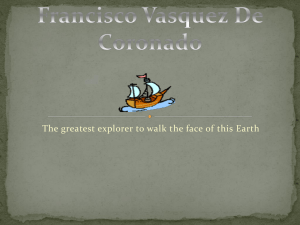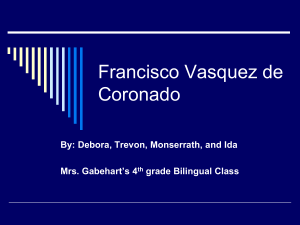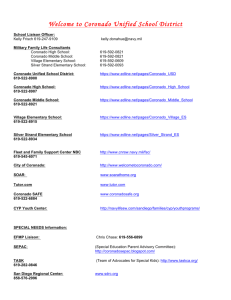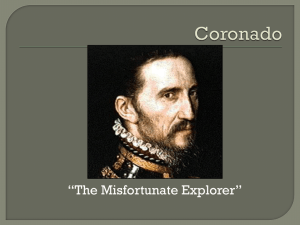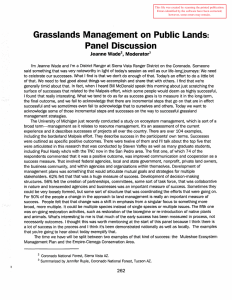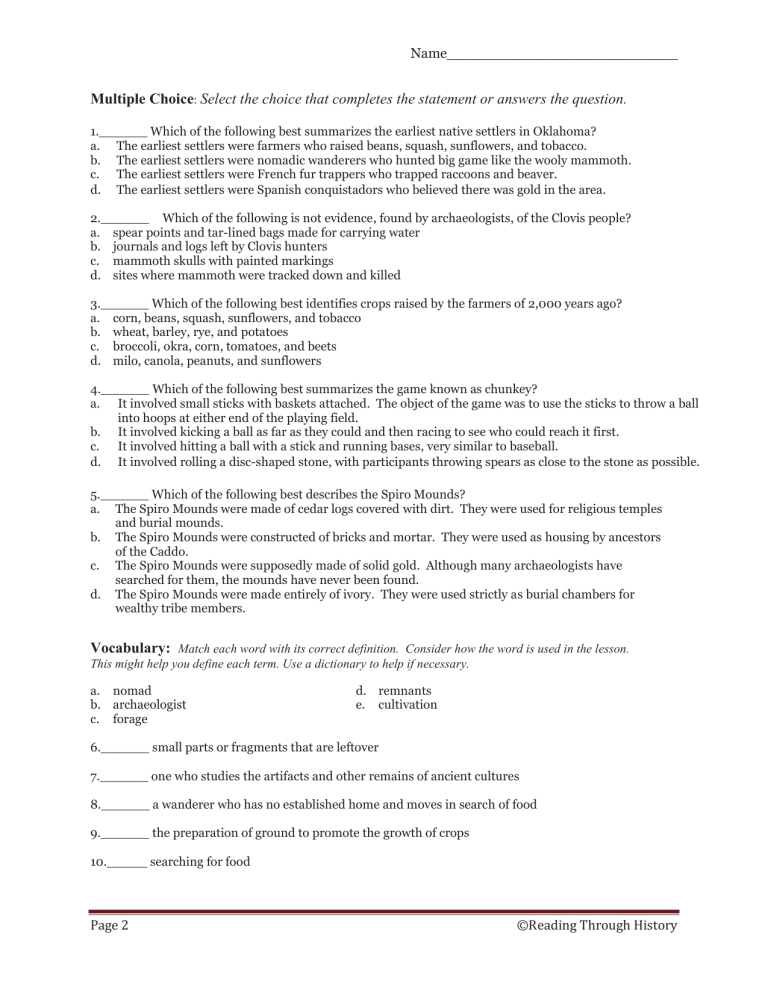
Name__________________________ Multiple Choice: Select the choice that completes the statement or answers the question. 1.______ Which of the following best summarizes the earliest native settlers in Oklahoma? a. The earliest settlers were farmers who raised beans, squash, sunflowers, and tobacco. b. The earliest settlers were nomadic wanderers who hunted big game like the wooly mammoth. c. The earliest settlers were French fur trappers who trapped raccoons and beaver. d. The earliest settlers were Spanish conquistadors who believed there was gold in the area. 2.______ Which of the following is not evidence, found by archaeologists, of the Clovis people? a. spear points and tar-lined bags made for carrying water b. journals and logs left by Clovis hunters c. mammoth skulls with painted markings d. sites where mammoth were tracked down and killed 3.______ Which of the following best identifies crops raised by the farmers of 2,000 years ago? a. corn, beans, squash, sunflowers, and tobacco b. wheat, barley, rye, and potatoes c. broccoli, okra, corn, tomatoes, and beets d. milo, canola, peanuts, and sunflowers 4.______ Which of the following best summarizes the game known as chunkey? a. It involved small sticks with baskets attached. The object of the game was to use the sticks to throw a ball into hoops at either end of the playing field. b. It involved kicking a ball as far as they could and then racing to see who could reach it first. c. It involved hitting a ball with a stick and running bases, very similar to baseball. d. It involved rolling a disc-shaped stone, with participants throwing spears as close to the stone as possible. 5.______ Which of the following best describes the Spiro Mounds? a. The Spiro Mounds were made of cedar logs covered with dirt. They were used for religious temples and burial mounds. b. The Spiro Mounds were constructed of bricks and mortar. They were used as housing by ancestors of the Caddo. c. The Spiro Mounds were supposedly made of solid gold. Although many archaeologists have searched for them, the mounds have never been found. d. The Spiro Mounds were made entirely of ivory. They were used strictly as burial chambers for wealthy tribe members. Vocabulary: Match each word with its correct definition. Consider how the word is used in the lesson. This might help you define each term. Use a dictionary to help if necessary. a. nomad b. archaeologist c. forage d. remnants e. cultivation 6.______ small parts or fragments that are leftover 7.______ one who studies the artifacts and other remains of ancient cultures 8.______ a wanderer who has no established home and moves in search of food 9.______ the preparation of ground to promote the growth of crops 10._____ searching for food Page 2 ©Reading Through History Name__________________________ Guided Reading: Fill in the blanks below to create complete sentences. 1. The earliest natives to live in Oklahoma were nomadic ________________. 2. _________________________ have found considerable evidence of the Clovis peoples presence, as well as that of other ancient native tribes. 3. Foragers hunted smaller animals than their predecessors, including deer, antelope, ________________________, wild turkey, and even mice. 4. As time progressed, the native tribes living in Oklahoma began ________________. 5. The tribes of about 2,000 years ago also hunted, using bows and ________________, as well as axes. 6. The Spiro women produced garments, bags, and ____________________ made from various types of animal fur and feathers. 7. The tribe amused themselves by playing a game called ________________. 8. ________________________ Spiro Mounds have been discovered in all. 9. Many priceless artifacts had been taken from the Spiro Mounds and sold by ____________________. 10. Today, the mounds are located at the Spiro Mounds State Archaeological Park, which is just outside of _____________________________. ©Reading Through History Page 3 Name__________________________ Summarize: Answer the following questions in the space provided. Attempt to respond in a complete sentence for each question. Be sure to use correct capitalization and punctuation! 1. Who were the Spiro Mound builders the ancestors of? 2. What did foragers collect? 3. When were the Spiro Mounds excavated? 4. Where was the first evidence of the Clovis tribes found? 5. Why do you suppose so much is known about the Spiro Mound builders today? 6. How was cultivation done 2,000 years ago? Student Response: Write a paragraph addressing the questions raised below. A thorough response should consist of three to five complete sentences. 7. Why do you suppose it is so difficult for us to learn about ancient tribes that lived hundreds, or even thousands of years ago? Explain your answer as thoroughly as possible. Page 4 ©Reading Through History Name__________________________ From there, The Turk led Coronado’s expedition into the panhandle of Texas as well as Oklahoma, where Coronado took notes of what he observed. He and his men were awed by the vastness of the Great Plains. They saw enormous herds of buffalo, but few trees. In fact, there were so few trees that his men were reduced to using buffalo manure as fuel for their fires. He also observed a tribe of Apache who hunted the buffalo, ate the meat raw, and used the hides for tents and clothing. Coronado and his men traveled into Kansas and crossed the Arkansas River. Eventually, they arrived at a Native American village (most likely ancestors of the Wichita). It was not a city of gold as Coronado had hoped for. Instead, he had found straw-thatched huts and fields of corn, beans, and squash. He and his party stayed with the villagers for twenty-five days, making observations and taking notes. Disappointed, Coronado had The Turk executed for deceiving him before returning to Mexico. Friar Juan Padilla had traveled with Coronado during this first journey. After returning to Mexico, Friar Padilla hoped to Christianize the tribe they had visited. He, two of his followers, and a conquistador named Andres de Campo, set out to find the village once more. The villagers welcomed them warmly, and Friar Padilla had much success in his missionary work. Therefore, he and de Campo sought out another village. They found the Kaw tribe less receptive and Friar Padilla was killed. De Campo and Friar Padilla’s followers returned to Mexico, traveling through large portions of Kansas, central Oklahoma, and Texas. Just as Coronado had done, they took extensive notes of all that they saw. The three men finally returned to Mexico five years after their journey had begun. Juan de Oñate was another Spanish conquistador who was sure he could succeed where Coronado had failed. In 1601, he undertook his own expedition of the Great Plains in search of the fabled cities of gold. He explored the Canadian River region and saw vast prairies where “the grass was high enough to conceal a horse”. Similar to Coronado’s expedition, he found no cities of gold, only simple native villages. Page 6 ©Reading Through History Name__________________________ Multiple Choice: Select the choice that completes the statement or answers the question. 1.______ Which of the following statements about Francisco Coronado is not accurate? a. Coronado had traveled to New Spain (Mexico) in search of gold and glory. b. Coronado hoped to Christianize the natives while exploring North America. c. Coronado was a 25-year-old conquistador when his journey began. d. Coronado was searching for the Seven Cities of Cíbola. 2.______ Which of the following best summarizes how Coronado treated the Native Americans he encountered? a. He had little respect for the natives, forcing them to carry his equipment while robbing them of their food. b. Coronado was very friendly towards the natives and traded many items with them. c. Coronado attempted to be friendly but was chased away by the Native Americans who attacked him. d. Coronado did not encounter any Native Americans during his expedition. 3.______ Which of the following best describes the likely intentions of The Turk as he guided Coronado and his expedition? a. The Turk hoped to lead them to the mythical city of Quívíra. b. The Turk hoped to lead them into an ambush. c. The Turk hoped that Coronado might take him back to Spain. d. The Turk hoped to guide the Spaniards away from his own people. 4.______ Which of the following best summarizes the purpose of Juan Padilla’s expedition? a. Padilla was searching for the Seven Cities of Cíbola. b. Padilla was searching for the Fountain of Youth. c. Padilla was attempting to Christianize the Wichita Indians. d. Padilla was attempting to locate the source of the Red River. 5.______ Which of the following statements about Juan de Oñate is not true? a. Oñate was searching for the fabled cities of gold. b. Oñate explored the Canadian River and saw massive grass prairies. c. Oñate eventually climbed the Rocky Mountains. d. Oñate found no cities of gold, only simple native villages. Vocabulary: Match each word with its correct definition. Consider how the word is used in the lesson. This might help you define each term. Use a dictionary to help if necessary. a. conquistador b. adobe c. illusion d. Quívíra e. fabled 6.______ a legendary mythical city of gold 7.______ a Spanish explorer who arrived in North America during the 1500s 8.______ a false or misleading impression of reality 9.______ a building made of sun-dried bricks 10._____ having no real existence; fictitious ©Reading Through History Page 7 Name__________________________ Guided Reading: Fill in the blanks below to create complete sentences. 1. On February 23, 1540, Coronado set out with a large expedition of about 400 _________________. 2. Coronado traveled throughout the American southwest, exploring the regions that are now Arizona and _________________. 3. The Turk led Coronado’s expedition into the panhandle of Texas as well as Oklahoma, where Coronado and his men were awed by the vastness of the ____________________. 4. Villagers welcomed Friar Padilla warmly, and he had much success in his _________________ work. 5. Andres De Campo and Friar Padilla’s followers returned to Mexico and took extensive ________________ of all that they saw along the way. Correct the Statement: Each of the following sentences is false. Circle the incorrect word and write the word or phrase that makes the statement correct in the answer blank provided. 6. Francisco Coronado was a conquistador from France. _______________. 7. Coronado and his men were searching for the seven lost cities of silver. _______________. 8. The Turk led Coronado’s expedition into the panhandle of Texas and Nebraska. ______________________. 9. The Native Americans that Coronado found in Kansas were most likely ancestors of the Cherokee. _______________________. 10. Andres de Campo was a friar who hoped to Christianize the Wichita Indians. _________________________. Page 8 ©Reading Through History Name__________________________ Summarize: Answer the following questions in the space provided. Attempt to respond in a complete sentence for each question. Be sure to use correct capitalization and punctuation! 1. Who guided Coronado when he was searching for Quivira? 2. What did Coronado find that resembled gold when spotted from a distance? 3. When did Coronado depart on his expedition? 4. Which present-day states did Coronado visit? 5. Why was The Turk executed? 6. How did Friar Padilla’s expedition end? Student Response: Write a paragraph addressing the questions raised below. A thorough response should consist of three to five complete sentences. 7. Why do you suppose the conquistadors were so willing to believe stories about cities made of gold? Explain your answer as thoroughly as possible. ©Reading Through History Page 9 Name__________________________ Multiple Choice: Select the choice that completes the statement or answers the question. 1.______ Which of the following is not significant about Robert de LaSalle? a. He established several forts along the Mississippi River. b. He gave the name Louisiana to the area west of the Mississippi River. c. He explored the Louisiana Territory and made detailed maps of the area. d. He claimed Louisiana Territory for France. 2.______ Which of the following best summarizes Bernard LaHarpe’s journey? a. He followed the Red River, traveled through the Ouachita Mountains, and eventually found a large settlement of Wichita Indians. b. He followed the Arkansas River, traveled through the Winding Stair Mountains, and eventually found a large settlement of Osage Indians. c. He followed the Mississippi River and established several trading posts, one of which eventually became Little Rock, Arkansas. d. He followed the Colorado River, traveled through the Rocky Mountains, and eventually reached the Pacific Ocean. 3.______ Which of the following accurately summarizes the notes LaHarpe made about his journey? a. He noted that the Wichita were unfriendly, the area was virtually devoid of wildlife, and that the land was a barren desert. b. He noted that there was little water, very few trees, and it was not fit for human habitation. c. He noted that the local natives were very hostile, most of the wildlife was predatory in nature, and overall the territory was a very dangerous place. d. He noted that the Wichita were excellent farmers, the area was plentiful in wildlife, and that the land was fertile and rich in minerals. 4.______ Which of the following best describes the relationship between the French and Native Americans? a. The French were rude to the Native Americans and had a difficult time getting along with them. b. The French treated the Native Americans well and were able to establish good trade relations with them. c. The French attacked the Native Americans immediately and attempted to chase them out of the area. d. The French did not encounter any Native Americans during the earliest explorations of the Louisiana Territory. 5.______ Why are Pierre Laclede and Auguste Chouteau significant? a. They were the first men to find the source of the Red River. b. They established several forts on the Mississippi River, including New Orleans. c. They were fur traders who settled in the region and made fur trading a valuable enterprise. d. They were missionaries who worked in and amongst the Wichita for many years. ©Reading Through History Page 11 Name__________________________ Guided Reading: Fill in the blanks below to create complete sentences. 1. Robert de LaSalle was a _______________ explorer who had arrived in North America in 1666. 2. During LaSalle’s travels, he also established the outpost that would eventually become _______________________, Arkansas. 3. LaHarpe and his men followed the Red River to where the present-day town of ____________________, Oklahoma is. 4. LaSalle and his party came across a large Wichita settlement which they estimated had between 6,000 and _____________________ people. 5. LaHarpe noted that the forests were full of animals, and the streams and rivers were teeming with ____________________. 6. LaHarpe treated his hosts well, giving the local chiefs ________________ of guns, knives, hatchets, and paint. 7. In no time at all, French fur ___________________ and traders had moved into the region, hunting for buffalo hide, deer skins, beaver skins, and many other types of fur. 8. The work of these French explorers, trappers, and traders was significant, for they made the first extensive _______________________ of the area. 9. Evidence of the French presence in Oklahoma can still be found in some _______________ names. 10. Sallisaw, ____________________, Chouteau, and Kiamichi are all town names with French origins. Vocabulary: Match each word with its correct definition. Consider how the word is used in the lesson. This might help you define each term. Use a dictionary to help if necessary. a. intention b. extensive c. fertile d. enterprise e. asset 11.______ far-reaching; comprehensive; thorough 12.______ the purpose or reason a certain action was done; goal 13.______ a useful or desirable thing 14.______ capable of producing vegetation 15.______ a commercial business Page 12 ©Reading Through History Name__________________________ Summarize: Answer the following questions in the space provided. Attempt to respond in a complete sentence for each question. Be sure to use correct capitalization and punctuation. 1. Who named the territory “Louisiana”? 2. What gifts did LaHarpe give to the local chiefs? 3. When did Robert de LaSalle arrive in North America? 4. Where did LaHarpe find the large settlement of Wichita? 5. Why were the French able to establish good trading relations with the Native Americans? 6. How were the efforts of the French explorers able to help the American explorers who arrived in the early 1800s? Student Response: Write a paragraph addressing the questions raised below. A thorough response should consist of three to five complete sentences. 7. History shows us that the native tribes reacted to Spanish and French explorers very differently. Why might this have been the case? Explain your answer as thoroughly as possible. ©Reading Through History Page 13 Name__________________________ Multiple Choice: Select the choice that completes the statement or answers the question. 1.______ Which of the following best summarizes the purpose of Zebulon Pike’s expedition? a. He was to find Pike’s Peak and climb it. b. He was to find the source of the Arkansas and Red Rivers, make detailed maps, and determine the value of natural resources. c. He was to find the source of the Mississippi River and establish friendly relationships with Native American tribes. d. He was to find deposits of salt and silver, as well search for the mythical cities of gold that Coronado had searched for. 2.______ Which of the following best summarizes the expedition led by Lt. James Wilkinson? a. They explored the Arkansas River through the winter months, facing extreme cold and ice. b. They explored the Red River through the summer months, facing extreme heat with little water. c. They explored the Canadian River through the spring and thought the region was wonderful. d. They explored the Arkansas River through the fall months and became hopelessly lost. 3.______ Which of the following significant discoveries did George Sibley make? a. He discovered the Sibley Falls, which is the tallest waterfall in North America. b. He discovered Sibley Peak, which is the tallest mountain west of the Mississippi River. c. He discovered the Great Plains and gave it the nickname “the Great American Desert”. d. He discovered the Great Salt Plains, “an inexhaustible supply of ready-made salt.” 4.______ Which of the following best summarizes what Stephen Long described during his journey through the Louisiana Territory? a. He described it as one of the most beautiful places he had ever seen, with many trees and abundant wildlife. b. He described it as a great desert, with little timber or surface water, and not fit for settlement or agriculture. c. He described it as a frozen tundra, with very little water and no plant life. d. He described it as a perfect spot for farming, with thousands of acres of flat ground and fertile fields. 5.______ Which of the following best describes Thomas Nuttall’s contribution to exploring the Louisiana Territory? a. He was the first to see the Gloss Mountains and gave them their name. b. He discovered the source of the Arkansas River and followed it back to the Mississippi. c. He located the Great Salt Plains and took extensive notes about the region. d. He studied the wide variety of plant and animal life found in the Louisiana Territory. Page 16 ©Reading Through History Name__________________________ Vocabulary: Match each word with its correct definition. Consider how the word is used in the lesson. This might help you define each term. Use a dictionary to help if necessary. a. summit b. comprehensive c. tributary d. topography e. botanist 1.______ a stream that flows into a larger river 2.______ a scientist who studies plant life 3.______ a large scope; covering or involving much; all-inclusive 4.______ the land forms or surface features of a region 5.______ the highest point of a hill or mountain Guided Reading: Fill in the blanks below to create complete sentences. 6. In 1803, the United States purchased the Louisiana Territory from France for ________________. 7. Pike was given instructions to find the ________________ of the Arkansas River and Red River. 8. Pike took a small number of men, hoping to climb ___________________________, which is named after him today. 9. At one point during their journey, Pike and his men became lost, drifting into ________________held territory. 10. James Wilkinson and his men started in _________________, but were reduced to walking because of dry river beds. Correct the Statement: Each of the following sentences is false. Circle the incorrect word and write the word or phrase that makes the statement correct in the answer blank provided. 11. George Sibley was an agent of the U.S. Government who was sent to negotiate with the Apache. ___________________. 12. Stephen H. Long and John Bell were to explore the Red River and Canadian River and map out the area. ____________________. 13. John Bell and his twelve men traveled through portions of Oklahoma during the hot winter months. ____________________. 14. Stephen Long and his expedition were to explore the Red River, but they became lost and ended up on the Colorado River instead. ___________________. 15. Thomas Nuttall was a biologist who studied the wide variety of plant and animal life he observed. ____________________. ©Reading Through History Page 17 Name__________________________ Summarize: Answer the following questions in the space provided. Attempt to respond in a complete sentence for each question. Be sure to use correct capitalization and punctuation! 1. Who was sent to explore the northern region of the Louisiana Territory? 2. What phrase came to be widely used to describe the region that Stephen Long explored? 3. When did Zebulon Pike’s journey begin? 4. Where is the Big Salt Plain? 5. Why did Stephen Long not feel that the area was fit for settlement? 6. How did James Wilkinson’s expedition manage to survive? Student Response: Write a paragraph addressing the questions raised below. A thorough response should consist of three to five complete sentences. 7. Stephen Long referred to part of the Louisiana Territory as “a great desert” and stated that it was not fit for settlement. How was his opinion of the region shaped? Cite specific textual evidence to help support your answer. Page 18 ©Reading Through History
